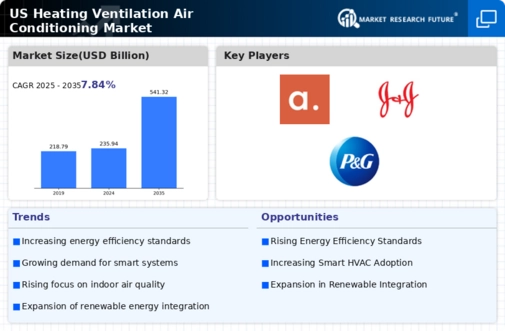Regulatory Compliance and Standards
The heating ventilation-air-conditioning market is increasingly influenced by stringent regulatory compliance and standards set by government bodies. These regulations often mandate energy efficiency and emissions reductions, compelling manufacturers to innovate and adapt their products. For instance, the U.S. Department of Energy has established efficiency standards that require HVAC systems to meet specific performance metrics. This regulatory landscape not only drives technological advancements but also shapes consumer preferences towards more efficient systems. As a result, companies that align their offerings with these regulations are likely to gain a competitive edge in the heating ventilation-air-conditioning market. Furthermore, compliance with these standards can lead to potential cost savings for consumers, thereby enhancing market demand.
Climate Change and Environmental Concerns
The heating ventilation-air-conditioning market is being shaped by heightened awareness of climate change and environmental concerns. As consumers and businesses alike become more conscious of their carbon footprints, there is a growing demand for HVAC systems that utilize eco-friendly refrigerants and energy-efficient technologies. The U.S. government has initiated various programs aimed at promoting sustainable practices within the industry, which further drives innovation. For instance, the transition to low-GWP (Global Warming Potential) refrigerants is becoming a priority for manufacturers. This shift not only addresses environmental concerns but also aligns with consumer preferences for sustainable products. Consequently, the heating ventilation-air-conditioning market is likely to see a surge in demand for environmentally friendly solutions.
Consumer Awareness and Demand for Comfort
The heating ventilation-air-conditioning market is significantly impacted by growing consumer awareness regarding indoor comfort and climate control. As individuals become more informed about the benefits of maintaining optimal indoor temperatures and air quality, the demand for advanced HVAC systems is likely to rise. Surveys indicate that over 70% of homeowners prioritize comfort and energy efficiency when selecting HVAC systems. This shift in consumer preferences is prompting manufacturers to develop products that not only meet basic heating and cooling needs but also offer enhanced features such as smart controls and improved air filtration. Consequently, the heating ventilation-air-conditioning market is evolving to cater to these demands, fostering a competitive environment among industry players.
Technological Advancements in HVAC Systems
The heating ventilation-air-conditioning market is witnessing rapid technological advancements that are reshaping the industry landscape. Innovations such as variable refrigerant flow systems, advanced thermostats, and IoT-enabled devices are becoming increasingly prevalent. These technologies enhance system efficiency, reduce energy consumption, and improve user experience. For example, smart thermostats can optimize energy usage by learning user preferences and adjusting settings accordingly. The integration of these technologies is not only appealing to environmentally conscious consumers but also aligns with regulatory trends towards energy efficiency. As a result, companies that invest in research and development to incorporate these advancements are likely to thrive in the competitive heating ventilation-air-conditioning market.
Rising Construction and Renovation Activities
The heating ventilation-air-conditioning market is experiencing a boost due to the rising construction and renovation activities across the United States. As urbanization continues to expand, new residential and commercial buildings are being constructed, necessitating the installation of efficient HVAC systems. According to recent data, the construction sector has seen a growth rate of approximately 5% annually, which directly correlates with increased demand for heating ventilation-air-conditioning solutions. Additionally, renovation projects often require upgrades to existing HVAC systems to meet modern efficiency standards. This trend not only stimulates market growth but also encourages innovation in product offerings, as consumers seek advanced solutions that enhance comfort and energy efficiency.














Leave a Comment